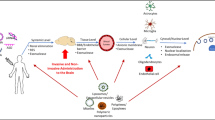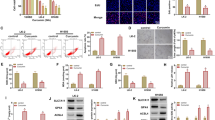Abstract
Clinical application of local anesthetic reagent, liposomal bupivacaine (BUP), may cause irreversible damage to human nerve system. In this study, we explored the functional role of long non-coding RNA (lncRNA) small nucleolar RNA host gene 16 (SNHG16) in BUP-induced neurotoxicity in SH-SY5Y cells. SH-SY5Y cells were treated with BUP in vitro, whose dose-dependent effects on cell viability and SNHG16 expression were explored. SNHG16 was upregulated in SH-SY5Y cells. The protection of SNHG16 upregulation on BUP-induced neurotoxicity was examined by viability assay, apoptosis assay, and caspase activity assay, respectively. The endogenously competing target of SNHG16, human mature microRNA-132-3p (hsa-miR-132-3p), was explored by dual-luciferase assay and quantitative real-time PCR (qRT-PCR). Hsa-miR-132-3p was then further overexpressed in SNHG16-upregulated SH-SY5Y cells to explore its functional role in BUP-induced neurotoxicity. BUP induced dose-dependent cell death and SNHG16 downregulation in SH-SY5Y cells. Inversely, lentivirus-mediated SNHG16 upregulation mitigated cell death. In addition, SNHG16 upregulation rescued BUP-induced apoptosis and caspase 3/7 augmentation. Hsa-miR-132-3p was found to be reversely expressed with SNHG16 in BUP-treated SH-SY5Y cells. Overexpressing hsa-miR-132-3p reduced the protection of SNHG16 on BUP-induced neurotoxicity. We demonstrated that epigenetic axis of SNHG16/hsa-miR-132-3p had a functional role in regulating anesthesia-induced neurotoxicity in human lineage neural cells.




Similar content being viewed by others
References
Chen L, Li Q, Wang H, Chen Q, Wu Y, Shang Y (2018) Paeoniflorin attenuated bupivacaine-induced neurotoxicity in SH-SY5Y cells via suppression of the p38 MAPK pathway. J Cell Biochem. 2018 https://doi.org/10.1002/jcb.27964. [Epub ahead of print]
Clark MB, Mattick JS (2011) Long noncoding RNAs in cell biology. Semin Cell Dev Biol 22:366–376
Disma N, O'Leary JD, Loepke AW, Brambrink AM, Becke K, Clausen NG, De Graaff JC, Liu F, Hansen TG, McCann ME, Salorio CF, Soriano S, Sun LS, Szmuk P, Warner DO, Vutskits L, Davidson AJ (2018) Anesthesia and the developing brain: a way forward for laboratory and clinical research. Paediatr Anaesth 28:758–763
Friederich P, Benzenberg D, Urban BW (2002) Bupivacaine inhibits human neuronal Kv3 channels in SH-SY5Y human neuroblastoma cells. Br J Anaesth 88:864–866
General Assembly of the World Medical, A (2014) World Medical Association Declaration of Helsinki: ethical principles for medical research involving human subjects. J Am Coll Dent 81:14–18
Ilfeld BM (2013) Liposome bupivacaine in peripheral nerve blocks and epidural injections to manage postoperative pain. Expert Opin Pharmacother 14:2421–2431
Jarroux J, Morillon A, Pinskaya M (2017) History, discovery, and classification of lncRNAs. Adv Exp Med Biol 1008:1–46
Li JH, Liu S, Zhou H, Qu LH, Yang JH (2014) starBase v2.0: decoding miRNA-ceRNA, miRNA-ncRNA and protein-RNA interaction networks from large-scale CLIP-Seq data. Nucleic Acids Res 42:D92–D97
Liu H, Chen B, Zhu Q (2019) Long non-coding RNA SNHG16 reduces hydrogen peroxide-induced cell injury in PC-12 cells by up-regulating microRNA-423-5p. Artif Cells Nanomed Biotechnol 47:1444–1451
Long Y, Wang X, Youmans DT, Cech TR (2017) How do lncRNAs regulate transcription? Sci Adv 3:eaao2110
Lu YF, Cai XL, Li ZZ, Lv J, Xiang YA, Chen JJ, Chen WJ, Sun WY, Liu XM, Chen JB (2018) LncRNA SNHG16 functions as an oncogene by sponging MiR-4518 and up-regulating PRMT5 expression in glioma. Cell Physiol Biochem 45:1975–1985
Mehran RJ, Walsh GL, Zalpour A, Cata JP, Correa AM, Antonoff MB, Rice DC (2017) Intercostal nerve blocks with liposomal bupivacaine: demonstration of safety, and potential benefits. Semin Thorac Cardiovasc Surg 29:531–537
Ng SY, Lin L, Soh BS, Stanton LW (2013) Long noncoding RNAs in development and disease of the central nervous system. Trends Genet 29:461–468
Panda AC (2018) Circular RNAs act as miRNA sponges. Adv Exp Med Biol 1087:67–79
Pang X, Su Z, Sun Y, Zhang W, Wang H (2018) Long noncoding RNA SNHG16 reduced ketamine-induced neurotoxicity in human embryonic stem cell-derived neurons. J Chem Neuroanat 94:39–45
Quan Z, Zheng D, Qing H (2017) Regulatory roles of long non-coding RNAs in the central nervous system and associated neurodegenerative diseases. Front Cell Neurosci 11:175
Qureshi IA, Mattick JS, Mehler MF (2010) Long non-coding RNAs in nervous system function and disease. Brain Res 1338:20–35
Sakura S, Kirihara Y, Muguruma T, Kishimoto T, Saito Y (2005) The comparative neurotoxicity of intrathecal lidocaine and bupivacaine in rats. Anesth Analg 101:541–547 table of contents
Sen R, Ghosal S, Das S, Balti S, Chakrabarti J (2014) Competing endogenous RNA: the key to posttranscriptional regulation. Sci World J 2014:896206
Thomson DW, Dinger ME (2016) Endogenous microRNA sponges: evidence and controversy. Nat Rev Genet 17:272–283
Tong YC, Kaye AD, Urman RD (2014) Liposomal bupivacaine and clinical outcomes. Best Pract Res Clin Anaesthesiol 28:15–27
Wang C, Slikker W Jr (2008) Strategies and experimental models for evaluating anesthetics: effects on the developing nervous system. Anesth Analg 106:1643–1658
Wen X, Xu S, Liu H, Zhang Q, Liang H, Yang C, Wang H (2013) Neurotoxicity induced by bupivacaine via T-type calcium channels in SH-SY5Y cells. PLoS One 8:e62942
Yamashita A, Matsumoto M, Matsumoto S, Itoh M, Kawai K, Sakabe T (2003) A comparison of the neurotoxic effects on the spinal cord of tetracaine, lidocaine, bupivacaine, and ropivacaine administered intrathecally in rabbits. Anesth Analg 97:512–519 table of contents
Yang JH, Li JH, Shao P, Zhou H, Chen YQ, Qu LH (2011) starBase: a database for exploring microRNA-mRNA interaction maps from Argonaute CLIP-Seq and Degradome-Seq data. Nucleic Acids Res 39:D202–D209
Yang BY, Meng Q, Sun Y, Gao L, Yang JX (2018) Long non-coding RNA SNHG16 contributes to glioma malignancy by competitively binding miR-20a-5p with E2F1. J Biol Regul Homeost Agents 32:251–261
Yu Y, Chen F, Yang Y, Jin Y, Shi J, Han S, Chu P, Lu J, Tai J, Wang S, Yang W, Wang H, Guo Y, Ni X (2019) lncRNA SNHG16 is associated with proliferation and poor prognosis of pediatric neuroblastoma. Int J Oncol 55:93–102
Zhang H, Lin J, Hu T, Ren Z, Wang W, He Q (2019) Effect of miR-132 on bupivacaine-induced neurotoxicity in human neuroblastoma cell line. J Pharmacol Sci 139:186–192
Zimmer C, Piepenbrink K, Riest G, Peters J (2007) Cardiotoxic and neurotoxic effects after accidental intravascular bupivacaine administration. Therapy with lidocaine propofol and lipid emulsion. Anaesthesist 56:449–453
Author information
Authors and Affiliations
Corresponding author
Ethics declarations
Conflict of Interest
The authors declare that they have no conflict of interest.
Ethics Statement
In this work, all experimental protocols were reviewed and approved by the Clinical Study & Ethic Committee at the Beijing Shijitan Hospital, Capital Medical University in Bejing, China. Also, this work was conducted in accordance with the World Medical Association Declaration of Helsinki (General Assembly of the World Medical 2014).
Additional information
Publisher’s Note
Springer Nature remains neutral with regard to jurisdictional claims in published maps and institutional affiliations.
Rights and permissions
About this article
Cite this article
Guan, L., Li, T. & Jiang, J. Bupivacaine-Induced Neurotoxicity Is Modulated by Epigenetic Axis of Long Noncoding RNA SNHG16 and Hsa-miR-132-3p. Neurotox Res 38, 175–183 (2020). https://doi.org/10.1007/s12640-020-00202-3
Received:
Revised:
Accepted:
Published:
Issue Date:
DOI: https://doi.org/10.1007/s12640-020-00202-3




